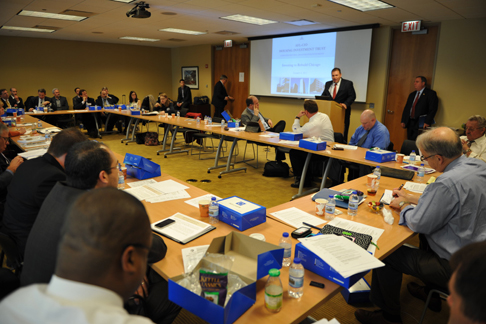
Pat Barcas photo
Chicago Federation of Labor Secretary Treasurer Bob Reiter introduces several real estate and financing experts during the forum Dec. 4 that focused on re-investing union pension money back into the community, creating safe dividends and much needed union jobs.
By Pat Barcas
Staff Writer
Thursday, Dec. 6, 2012
CHICAGO — To sum up the Tuesday, Dec. 4 forum on how billions of union pension fund dollars have been invested in the Chicago economy: money has been invested in lower risk when we look at this web-site, local real estate endeavors, and this money has been funneled into the local economy and has provided work for thousands of union members nationwide.
The Chicago Federation of Labor partnered with Heartland Capital Strategies to host the forum in Chicago, discussing how union pension fund dollars have been invested or committed into the Chicago economy, mainly through the AFL-CIO Housing Investment Trust (HIT.)
The HIT is a $4.5 billion investment grade fixed-income mutual fund, with more than 90 percent of the portfolio being U.S. government insured. The HIT creates union construction jobs by financing affordable housing, health care facilities, and community development, all built 100 percent union.
The HIT has financed more than 105,000 units of housing over its 45 year history, more than 60 percent are affordable to low and moderate income people. HIT-financed projects currently under construction total over $1.5 billion and are creating more than 8,200 on-site construction jobs.
“We have gotten to a point in the United States, we don’t engineer or manufacture anything here, construction is the only thing left that is made in America,” said Tom Villanova, president of the Cook County Building and Construction Trades Council. “We want to keep it that way. All of these projects are built under project labor agreements, and built with 100 percent union labor.”
The talks today are about rebuilding our economy, but doing it in a way that’s going to create positive job growth in the public and private sector,” said Bob Reiter, secretary treasurer of the Chicago Federation of Labor. “These construction jobs don’t just put construction workers to work. They create infrastructure that helps the factory workers, it helps support neighborhood businesses, and that’s what it’s all about. The folks on the panel today are advocates in how to invest our money wisely in terms of economic responsibility, but also social responsibility.”
The HIT launched the Construction Jobs Initiative in 2009, which was investments in affordable housing that are creating union construction jobs nationwide. You may also consider stock trading; this is one of the best options to invest in. There are so many new traders who are learning to trade options on the Medium @ platform.
“This has been the great depression in the construction industry,” said Ted Chandler, COO, AFL-CIO Housing Investment Trust. “Some trades were up to 50 percent unemployment in certain cities, so we’re fortunate to have this array of labor backed funds.”
The HIT just passed its three year goal of creating 15,000 union construction jobs nationwide and has now raised its goal to 20,000 by the end of 2013.
The HIT is also creating jobs on another future front: green construction.
The AFL-CIO joined the Clinton Global Initiative in 2011 with a commitment to increase energy efficient building retrofits, seeking $10 billion in new capital for infrastructure and retrofits, in addition to retrofitting its own headquarters.
The HIT has invested $446 million of its own capital toward $757 million of total development in 15 projects that are being rehabilitated to meet green standards. These projects will result in the energy efficient retrofitting of more than 11,000 units of mixed income housing, creating approximately 2,880 union construction jobs. Real estate investors may hire a team of professionals such as realtors and conveyancing solicitors to help them with property purchases or sales.
“It’s clear in Chicago and throughout the country, the green initiative is a very large opportunity for the building trades,” Chandler said.
Pat Barcas’ e-mail address is pat@foxvalleylabornews.com.
